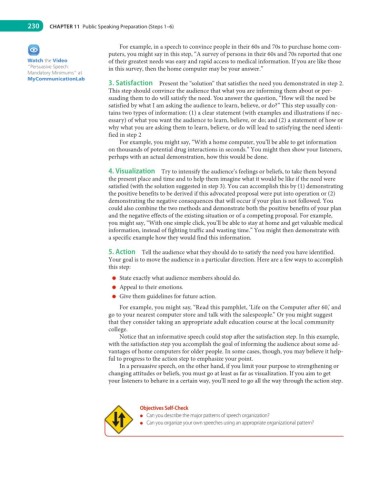Page 251 - Essentials of Human Communication
P. 251
230 CHAPTER 11 Public Speaking Preparation (Steps 1–6)
For example, in a speech to convince people in their 60s and 70s to purchase home com-
puters, you might say in this step, “A survey of persons in their 60s and 70s reported that one
Watch the Video of their greatest needs was easy and rapid access to medical information. If you are like those
“Persuasive Speech: in this survey, then the home computer may be your answer.”
Mandatory Minimums” at
MyCommunicationLab
3. satisfaction Present the “solution” that satisfies the need you demonstrated in step 2.
This step should convince the audience that what you are informing them about or per-
suading them to do will satisfy the need. You answer the question, “How will the need be
satisfied by what I am asking the audience to learn, believe, or do?” This step usually con-
tains two types of information: (1) a clear statement (with examples and illustrations if nec-
essary) of what you want the audience to learn, believe, or do; and (2) a statement of how or
why what you are asking them to learn, believe, or do will lead to satisfying the need identi-
fied in step 2
For example, you might say, “With a home computer, you’ll be able to get information
on thousands of potential drug interactions in seconds.” You might then show your listeners,
perhaps with an actual demonstration, how this would be done.
4. visualization Try to intensify the audience’s feelings or beliefs, to take them beyond
the present place and time and to help them imagine what it would be like if the need were
satisfied (with the solution suggested in step 3). You can accomplish this by (1) demonstrating
the positive benefits to be derived if this advocated proposal were put into operation or (2)
demonstrating the negative consequences that will occur if your plan is not followed. You
could also combine the two methods and demonstrate both the positive benefits of your plan
and the negative effects of the existing situation or of a competing proposal. For example,
you might say, “With one simple click, you’ll be able to stay at home and get valuable medical
information, instead of fighting traffic and wasting time.” You might then demonstrate with
a specific example how they would find this information.
5. action Tell the audience what they should do to satisfy the need you have identified.
Your goal is to move the audience in a particular direction. Here are a few ways to accomplish
this step:
● State exactly what audience members should do.
● Appeal to their emotions.
● Give them guidelines for future action.
For example, you might say, “Read this pamphlet, ‘Life on the Computer after 60,’ and
go to your nearest computer store and talk with the salespeople.” Or you might suggest
that they consider taking an appropriate adult education course at the local community
college.
Notice that an informative speech could stop after the satisfaction step. In this example,
with the satisfaction step you accomplish the goal of informing the audience about some ad-
vantages of home computers for older people. In some cases, though, you may believe it help-
ful to progress to the action step to emphasize your point.
In a persuasive speech, on the other hand, if you limit your purpose to strengthening or
changing attitudes or beliefs, you must go at least as far as visualization. If you aim to get
your listeners to behave in a certain way, you’ll need to go all the way through the action step.
Objectives self-check
● Can you describe the major patterns of speech organization?
● Can you organize your own speeches using an appropriate organizational pattern?

